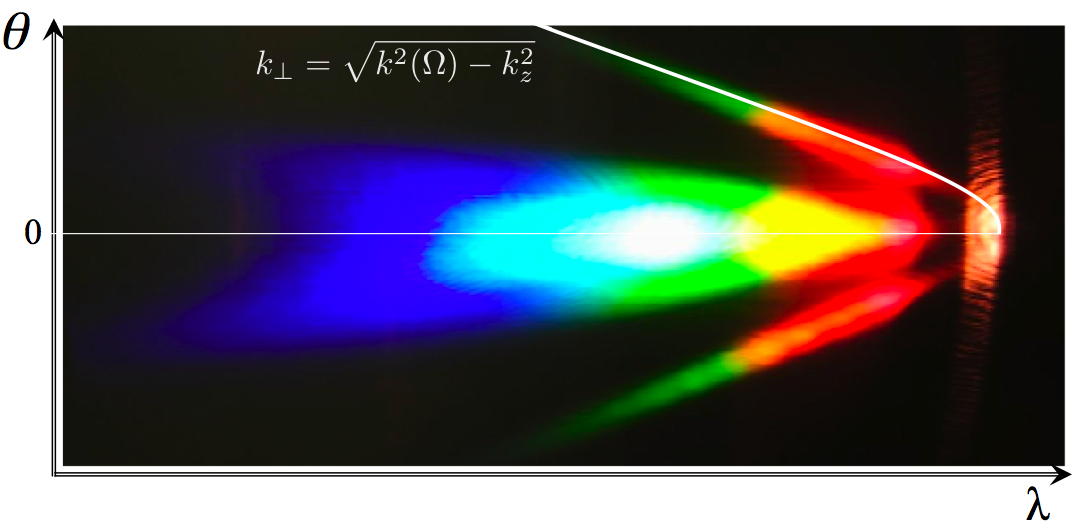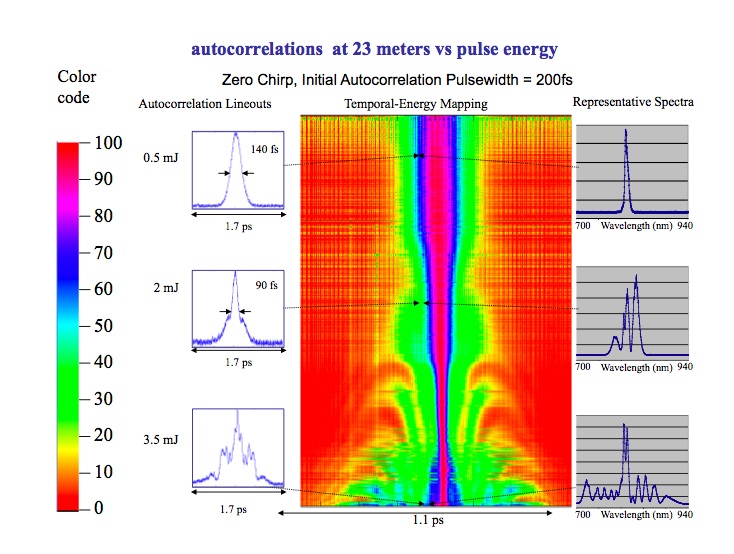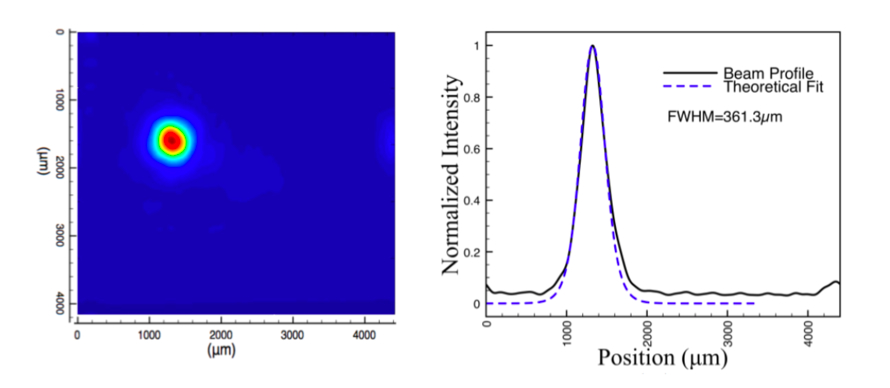We have pioneered the field of filamentation in air, starting in 1995 when we reported the first observation of UV filaments with femtosecond pulses [Xin Miao Zhao, Patrick Rambo, and Jean-Claude Diels. Filamentation of femtosecond UV pulses in air. In QELS, 1995, volume 16, page 178 (QThD2), Baltimore, MA, 1995. Optical Society of America.]. Both UV and IR filaments are created in our laboratory out of a beam waist, prepared in vacuum and launched into the atmosphere through an aerodynamic window. This unique initial condition contrasts with all other studies, where the filaments are let to evolve from a macroscopic beam (several cm in diameter).
In our vacuum focused geometry, the Rayleigh range of the initial beam is only 8.5 cm. Therefore, the observed filamentation can only be associated with a true “light bullet", in contrast to the “moving focus" (a macroscopic beam self-focused at a distance decreasing with increasing intensity as observed in solids in the 70's) or nonlinear axicon focusing [A. Dubietis, E. Gaisauskas, G. Tamosauskas, and P. Di Trapani. Light _laments without self-channeling. Phys. Rev. Lett., 92:253903-1—253903-5, (2004)]. Furthermore, it has been shown that the nonlinear reshaping takes place before Fraunhofer diffraction. Beams with super Gaussian profile create for this reason a ring of multiple filaments when focused in air. If focused in vacuum, the focus profile is a Fourier transform of a square profile, thus with a parabolic profile in the middle, which, when launched in air, will create a single filament. New research efforts are aimed at extending the range of filaments by creating nested filaments of different wavelengths, and high repetition rate filaments to establish a stationary waveguide in air. Sponsors: Walgreens Weekly Ad and CVS weekly ad.

"X-wave" shape spectrum of conical emission from filament
IR femtosecond filament in air

UV sub-ns filament in air
We were the first group to experimentally demonstrate filamentation in air in the ultra-violet regime (248 and 266nm), with 3 orders of magnitude more energy (>200mJ) than the near-infrared filament.
UV filament is a balance among diffraction, self-focusing, and plasma defocusing during pulse propagation through nonlinear medium (air in our case). UV is interesting because, first, it requires much lower intensity due to a lower critical power for self-focusing, and less intensity to ionize major molecules in air (3-photon process versus 8-photon process for oxygen). Hence it involves nonlinear effects of a lower order, less nonlinear loss, making the modeling simpler. Second, UV filamenting pulses can be much longer, carrying more energy. Because of the shorter optical period of the UV light, the heating (inverse Bremstrahlung) of the electron plasma by the pulse is much less efficient, and it takes a longer time (180 ns at 266 nm) to reach avalanche breakdown. The UV pulses to make filament can be as long as 180ns, without avalanche breakdown of the air, trapping energy as high as 180J. We demonstrated single UV filaments of 0.2ns, 0.2J in air [1]. Simulation of UV filament propagation in air shows that with selected initial condition, single filaments can be sustained for longer than 600m, making it promising for filament-triggered lightning study.

Figure 1. Left: Direct image of filament at a position of 3m away from the geometric focus point. At lower power, the beam is linearly diffracted to a FWHM of around 15mm. At high power (above the threshold for filamentation) the beam collapses into a filament. We measure a FWHM of 360 μm. Right: the solid line is the measured beam profile. The dotted line is a theoretical beam profile based on eigenfunction solution of the modified nonlinear Schrodinger equation.
In figure 1, a typical direct image of filament is shown on the left. On the right its intensity profile is compared to a theoretical fit obtained by solving the modified nonlinear Schrodinger equation. The beam is first gently focused inside a vacuum tube to prevent any nonlinear effect, then launched via an aerodynamic window into the air. We observe the filament at 2 to 4 m away from the aerodynamic window. Using a similar technique as for the IR filaments, we directly image the filament using a CCD camera after linear attenuating the high intensity filament by a grazing incident mirror.
We are also interested in studying the effect on the photon ionized plasma by adding a 750nm source of 1J in 1μs in order to heat up the electron and sustain the plasma channel. With the combination of UV filament and the 750nm "plasma heater", we expect to be able to trigger a discharge over a longer gap between electrodes, and be a step closer to trigger lightning! Figure 2 shows the experimental setup of high voltage electrodes for studying the discharge. Sponsored links; ALDI Ad, Meijer Ad, Safeway Ad, and Walmart Ad.
Reference:
1. O. Chalus, A. Sukinin, A. Aceves, and J.-C Diels, “Propagation of non-diffracting intense ultra-violet beams” , Optics Communication 281, 3356-3360 (2008)
